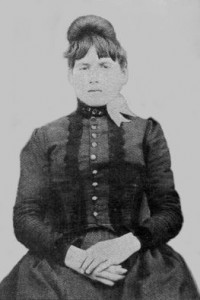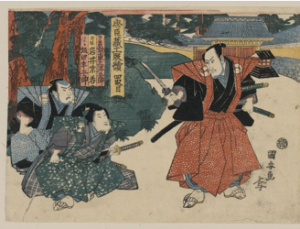Greenbrier County, West Virginia was a densely populated area. Nothing out of the ordinary ever occurred there until 1897, when a shocking death created an outburst and made headlines. Elva Zona Heaster was victim to a horrible murder that had originally been judged as “death by natural causes.”1
In 1895, Heaster gave birth to an illegitimate child. The next year she met Erasmus Stribbling Shue, and the couple soon married and were known to be inseparable. Despite the love the couple had for one another, Mary Jane Robinson Heaster, Zona Heaster’s mother, was not very impressed by Erasmus Shue, and disapproved of their marriage. Despite this, the couple continued to live together.

Erasmus Shue had initially moved to Greenbrier County to work as a blacksmith. Months went by and the couple seemed to live a normal life. On January 23, 1897, Shue sent a young boy that worked with him in the blacksmith shop to run an errand for him. The young boy obliged and walked to the couple’s house to do as he was told. Upon entering the house, the boy found Heaster lying at the bottom of a stairwell. Knowing that Heaster was dead, the young boy ran to his mother and notified her of what he had seen. The local doctor, police, and Shue were notified. Shue was the first to arrive on the scene; he carried his wife up the stairs and laid her on their bed, where he proceeded to dress her. His actions were very out of the ordinary considering the custom was for the ladies of the community to dress her in appropriate burial wear. Shue dressed her in a stiff-collared dress and a large veil. The local doctor, Dr. Knapp, was sent to examine the body, but was having difficulties since Heaster’s husband refused to let go of her, cradling her head and hysterically crying. As a result, Dr. Knapp declared her cause of death to be “an everlasting faint,” but then changed his statement to “childbirth.” What was particularly interesting was that Heaster had told no one that she was pregnant, nor did she appear to have signs or symptoms of pregnancy. Soon after, Heaster’s mother was notified and she immediately blamed Shue for Zona’s death.2
Mary Jane, Heaster’s mother, began praying and asking God to give her the name of the person guilty of her daughter’s murder. About four weeks after the death of her daughter, Mary Jane claimed to have had visions of a ghostly appearance telling her that Shue had killed her daughter. This occurrence happened four nights in a row, and began to make Mary Jane very ill. She decided to take her testimony to a prosecutor, John Alfred Preston. The prosecutor was hesitant about taking her case, but decided to do research on his own before believing Mary Jane. He went around the town asking for testimonies on the matter and found that Dr. Knapp admitted to not having been able to conduct a complete examination of the body. Neighbors noticed that during the viewing of Heaster, Shue never left the side of the coffin and didn’t let anyone look at her closely. As the pieces of the mysterious death finally fell into place, the prosecutor decided to take on the case. The prosecutor was able to obtain a warrant that allowed the body to be exhumed for re-examination.3
After a complete autopsy was performed, doctors found that Heaster’s neck had been broken and the bruising around her neck indicated that her windpipe had been severely crushed, as if she had been strangled. After the autopsy had been concluded, Shue was arrested and taken into custody for a later trial.4
The trial started on June 23, 1897, and lasted for eight days before the jury decided on a verdict. During the trial, the prosecutor tried to avoid using Mary Jane’s testimony due to the misunderstanding the jury might have. Regardless of these allegations, Mary Jane went ahead and revealed how she knew that Shue had murdered her daughter. Shue’s attorney immediately rejected the idea claiming that Mary Jane was crazy and unstable. The jury, however, found her story credible but did not mention it again after the first statement. The evidence against Shue was overwhelming and on the last day of the trial the jurors finally decided on a verdict. Ten of the twelve jurors voted on execution, but since it was not a unanimous decision, Shue was eventually sentenced to life in prison for first degree murder of Elva Zona Heaster.5
After the sentence, Shue was sent to prison, but the overwhelming disagreement on behalf of the community caused an outraged. Greenbrier County citizens felt that Shue should be hanged for his crime. On July 11, 1897, an angry mob gathered and threatened to lynch Shue, but the sheriff heard what was happening, and hid Shue in the woods before the mob could reach him. The Sheriff calmed the mob and eventually everyone went home.6
On July 13, 1897, Shue was placed in the state penitentiary where he eventually died of natural causes on March 13, 1900.7
The ordeal of the Greenbrier Ghost has sparked interest in many paranormal investigators and has made West Virginia a popular tourist attraction. No real evidence has been found on the Greenbrier ghost that Mary Jane claimed revealed her daughter’s murderer. The case is particularly interesting because at the time, investigators could not have revealed the murderer, due to the obvious lack of technology or forensic evidence. The only person that could have any other reliable testimony on the case would be the young boy that found Zona Heaster dead. From what was uncovered, the case can only be concluded as “Murder Solved by Ghost.”
- Katie Lyle, Man Who Wanted Seven Wives: The Greenbrier Ghost and the Famous Murder Mystery of 1897 (Charleston, W. Va: Quarrier, 1999), 6. ↵
- Katie Lyle, Man Who Wanted Seven Wives: The Greenbrier Ghost and the Famous Murder Mystery of 1897 (Charleston, W. Va: Quarrier, 1999), 6. ↵
- “EDITORIAL: West Virginia ghost stories recounted in new book,” Charleston Gazette, The (WV), November 01. Newspaper Source, EBSCOhost (accessed October 10, 2017). ↵
- Mike Conley, “Mike Conley’s Tales of the Weird: Ghost brings murderer to justice,” McDowell News, The (NC), August 27. Newspaper Source, EBSCOhost (accessed October 10, 2017). ↵
- Katie Lyle, Man Who Wanted Seven Wives: The Greenbrier Ghost and the Famous Murder Mystery of 1897 (Charleston, W. Va: Quarrier, 1999), 6. ↵
- “EDITORIAL: West Virginia ghost stories recounted in new book,” Charleston Gazette, The (WV), November 01. Newspaper Source, EBSCOhost (accessed October 10, 2017). ↵
- Mike Conley, “Mike Conley’s Tales of the Weird: Ghost brings murderer to justice,” McDowell News, The (NC), August 27. Newspaper Source, EBSCOhost (accessed October 10, 2017). ↵



96 comments
Jacob Galan
I think this is the 1st case I’ve seen where a ghost has played a critical role in a murder case. Even while reading the article, it was obvious that Erasmus Shue was behind it since the actions that he was doing were pretty odd. When convicted and at the trial it is nice to see how far we have come in the jury system because when found guilty that 1st thing that they were trying to decide is whether to execute him or not. Even though the crime wasn’t that gory that death was the 1st choice and now if a similar death were to happen like that, he would still probably face life in prison.
Jose Chaman
It was clear from the beginning that Erasmus Shue was culprit. His behavior revealed that his was hiding something, but it is normal for people to have thought that it was the natural pain of mourning. This article does a great narrative job, and makes it way through the smoothly. What I found really hilarious was that after a month of the death of Jane, his mother claimed to have seen her ghost telling the name of the culprit, that, indeed, was Erasmus Shue. Very interesting interesting story.
Kasandra Ramirez Ferrer
I had never heard of this story before, I found it quite interesting and odd. As I read the article I kept thinking how suspicious is the fact that Heaster’s body was found by the boy who was doing an errand Shue told him to that required him to go inside their house, it also surprises me how the police could have declared Heaster’s death due to natural causes and then change it to murderer. Despite my opinion on Shue’s guiltiness, I found ridiculous how he was sent to prison because of what Heaste’s mother said about a ghostly figure she saw and blamed Shue for it.
Amelia Hew
Even though Erasmus’s action of refusing the doctors to examine his wife, Zona was highly suspicious, however I can’t believe that Erasmus was charged with murder of Zona after Zona’s mother claimed she saw a ghost that revealed Erasmus being the murderer of Zona. This even causes a public outrage and the crowd wanted him to be executed despite having no physical evidence stating that he was the one who murdered his own wife. Perhaps it is all Mary Jane’s idea to get rid of Erasmus after the death of her daughter? since she did not approve of their marriage in the first place.
Cynthia Perez
Love paranormal stories especially ones like this where the “idea” of a ghost within a dream ended up helping a physical inhuman case. Something out of the ordinary helping humanity in small ways. I’m also one to believe that dreams are capable of anything and in this case maybe it proved the mother’s deep rooted intuition of Shue being guilty. I mean he showed many signs leading to that, I would think the dreams were there to justify what she had already knew and believed. Really interesting article, a very mysterious story and greatly written.
Cristianna Tovar
I found it strange that Erasmus Shue didn’t allow anyone to see his wife’s body up close at her funeral. Although there were some instances in which he acted a bit strange, I couldn’t believe that he was sent to prison after Heaster’s mother claimed that a ghostly figure had revealed to her that it was Shue who had killed her daughter. It makes me wonder how many people were sent to prison or executed based on someone saying that they had a vision of them being guilty.
Vanessa Quetzeri
It’s crazy to think that there was a time where people could get away with murder due to the lack of technology and resources at that time. I don’t know how much I believe that this ghost came to see Elva Zona Heaster’s mother because it could have just been based off her mother’s intuition, but regardless this article is very interesting.
Eliezer Leal
This article was interesting to red, reading a ghost story usually is. Although personally I have not had any paranormal experience I am a superstitious person and I do believe that we can be visited by the spirits of people that have passed away, but to hear that a spirit helped solve her own murder is truly something. I could only imagine how difficult it was for Mary Jane to see her murdered daughter in her dreams asking for her murder to be brought to justice.
Kathryn Martinez
This was very interesting because nowadays if someone were to base evidence off a dream it would be thrown out of the courts. Now in this day in age forensic technology is far more advanced and these types of things are no longer needed. But if one were to state these kinds of things in court that would even raise a question to a person’s credibility or insanity.
Audrey Uribe
What a wild story! Crazy to imagine Mary Jane being so compelling that her dream was enough evidence to solve the murder case. Now in days with the forensic science we have, a dream would never hold up as evidence. I’m glad the investigation agreed to listen to her and believe her. I’m glad justice was served and peace was made. Fun article.